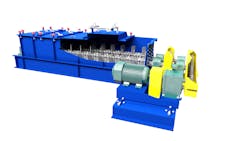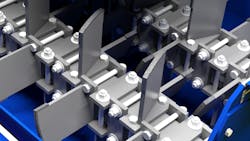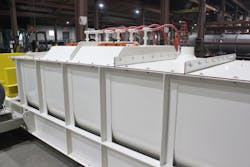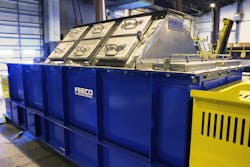Design considerations and modifications for industrial mixing equipment in harsh applications
Throughout many processes, industrial mixing equipment serves as an invaluable tool to accomplish a range of objectives, conditioning materials for landfill, enabling product quality requirements to be met and preparing materials for downstream processing.
It is not uncommon to encounter a mixing application that, for one reason or another, presents unique challenges that create a particularly harsh processing environment. In such settings, proper mixer design is critical to achieving a mixer that not only performs well, but that is also capable of withstanding the rigors of long-term production under such conditions.
In almost all cases, the results of inadequate mixer design are the same:
- Excessive downtime for maintenance and cleanout.
- Higher maintenance costs in both time and parts.
- Inefficient or ineffective operation.
- Frequent trough patching, paddle replacement, etc.
- Drive system failure.
- Reduced mixer life span.
The following information offers key considerations in mixer design and customization when working with difficult materials. While this article specifically references pugmill mixers, as they are a common choice for processing harsh bulk solids, many of the concepts described here apply to other types of industrial mixing equipment as well.
What makes a mixing application harsh?
A mixing application may be considered harsh for a number of reasons. An abrasive or corrosive material is by far the most common cause of a difficult mixing application, but a sticky or inconsistent material could also be to blame, as could the occurrence of a reaction during the mixing process. Mixing is especially harsh when two or more of these challenges are combined or paired with a high throughput.
An abrasive material
An abrasive material has the potential to cause excessive damage to parts such as shafts, seals and paddles. Abrasion is a frequent concern when working with materials such as silica, limestone and ores.
A corrosive material
Unlike an abrasive material, a corrosive material can cause damage beyond typical wear components, eating away at everything it comes into contact with. Corrosion is perhaps the single most problematic material property in the bulk processing space.
An inconsistent or sticky feedstock
Feedstock should ideally be as uniform as possible, but that is not always feasible. Non-uniform feedstocks often make feeding the process consistently a challenge. This is commonly seen with sludge-like materials, where variation in moisture content causes the consistency of the material to change.
A sticky material can cause similar problems, making adequate metering difficult, promoting excessive buildup and requiring frequent adjustments to keep things running smoothly.
The presence of a reaction
The presence of a reaction in the mixer adds a further layer of complexity for engineers designing the system. A reaction means that the material properties are changing as the material moves through the mixer, requiring careful consideration of the material at each point throughout its passage.
Furthermore, the presence of a reaction can introduce new elements to the mixing process such as heat or a rise in temperature, fugitive gases or dust, changes in consistency or even a new or increased risk of corrosion.
Key design considerations for industrial mixing equipment in harsh settings
Each mixing application presents its own unique challenges, requiring a flexible approach to mixer design. Mixers may require any number of modifications depending on the specific challenges of the process at hand. These customizations typically fall under a few key considerations:
Materials of construction
The most important consideration in mixer design for a harsh application is the selection of suitable materials of construction. While carbon steel is a commonly chosen material for other mixing applications, difficult materials typically require something more robust.
The materials of construction are of crucial importance when dealing with a material that is either abrasive or corrosive, as well as in the case of a reaction occurring.
Common design modifications
The materials of construction are highly dependent on the materials going into the mixer. The type of chemicals being added, as well as the concentration and grade of the chemicals, will influence the materials of construction.
For abrasion: Trough wear from abrasion is a common concern with many types of industrial mixing equipment but is less applicable to pugmill mixers; a gap between the paddle tips and the mixer trough promotes a slight buildup of material on the trough wall. This layer essentially serves as a self-made protective layer, preventing material from abrading the trough walls.
The shaft is protected by the paddles, backing plates and bolts, and therefore does not require further protection against abrasion. The paddles themselves may be lined with an abrasion-resistant material.
For corrosion: In selecting the proper materials of construction to fight against corrosion, engineers must first identify the actual mode of corrosion. Is it occurring as a result of the material’s pH, or is a high chloride content to blame? A material may also become more corrosive when it falls within a specific moisture or temperature range. In some cases, this could be addressed by adjusting the feedstock instead of opting for a more expensive alloy.
When a reaction occurs: As mentioned, the presence of a reaction requires engineers to consider the materials of construction for the characteristics of the material at every point throughout the mixer.
Depending on the specific components, this reaction could create a new chemical compound or may produce heat — both of which will affect the chosen materials of construction. Further, the presence of heat or a rise in material temperature often increases the corrosiveness of a material and must be accounted for.
At the same time, engineers must consider all potential worst-case scenarios. For example, if for some reason the reaction does not complete, unreacted or free acid would then be present in the mixer. As a precaution, the mixer would need to be constructed out of materials capable of withstanding exposure to free acid.
Engineers can take advantage of material test labs to assess the wear effects their particular material is likely to impart on different materials, or work with a stainless steel vendor to assess the various options. The decision often comes down to finding a balance between corrosion resistance and cost, as the more robust alloys quickly add cost to the unit.
Power requirements
Power requirements are another critical consideration in designing a mixer for a harsh setting. Adequate horsepower and torque are important in all applications, but they are especially crucial when working with thick, sludge-like or sticky materials, or when such a consistency will be produced as the result of a reaction occurring in the mixer.
The potential for tramp material to enter the mixer must also be considered in the selection of drive components.
Common design modifications
Mixers working with a sticky or sludge-like material will typically require high horsepower and torque to power through the resistance created by the material. When reacting a small amount of calcium oxide with water, for example, an exothermic reaction occurs that makes the mixture cementitious. This reaction requires enough power for the mixer to handle the consistency of the mix after it has reacted. In cases such as these, a high margin of safety is typically factored into the design.
In the case of tramp material, the mixer must be capable of producing enough torque to dislodge material in the event it becomes stuck.
The inclusion of a variable frequency drive (VFD) allows processors to respond to changes in feedstock (or the production environment) by controlling the motor speed. The use of a VFD in a pugmill mixer is a rather novel application, but is proving to offer operators a number of benefits and is therefore a growing trend.
Paddle arrangement
Many pugmill mixers are designed to accommodate various paddle arrangements. This gives operators a higher level of control over the material moving through the mixer.
Paddle arrangement plays a key role in mixer retention (residence) time, or the time required for the material to be in the mixer to produce the desired results. Retention time is of special importance when the mixer will carry out a reaction.
Paddle arrangement is also important when working with a sticky or sludge-like material. The chosen arrangement can either encourage or discourage the travel of material through the mixer. And if the arrangement was such that it discouraged conveying through the mixer, this could increase the amount of horsepower required in order to advance material, putting an added burden on the drive components.
Common design modifications
Several aspects of the paddle arrangement can be adjusted, including paddle placement, number of paddles, paddle direction and the pitch (angle) of paddles.
When a more turbulent mixing action is necessary to facilitate a reaction, some paddles can be reversed, causing material to collide against itself and creating a rolling action in the mixer. Likewise, paddles may be adjusted to create a gentler mixing action in the trough.
As mentioned, paddle arrangement has a significant amount of influence on retention time. When carrying out a reaction, this might necessitate the reversal of some paddles to increase retention time or create an artificial dam that will hold material in the mixer longer so the reaction can complete. Conversely, paddles may be adjusted in a way that pushes material through the mixer at a higher rate.
The spray system
The spray system of any industrial mixer is a very custom component when blending solid and liquid feeds into a homogeneous mixture. Careful spray system design is especially important when working with sticky materials, materials where the feed rate is difficult to control or materials that are dusty.
Common design modifications
As mentioned, spray systems are highly customizable, with a number of potential variables to adjust, including spray location, number of spray ports, height of spray system above material bed, nozzle type, spray rate, binder concentration, nozzle cleaning mechanisms and more.
Designing for sticky or hard-to-feed materials
In designing a spray system for sticky or hard-to-feed materials, binder feed rate must not only be measurable, but adjustable, so operators can respond in real time to changes in feedstock. Additional spray ports are often desirable as well, as this gives operators some flexibility in working with their material.
Designing for a dusty material
In order to keep dust down and provide a thorough distribution of the binder, the spray system is often positioned higher up from the material bed. This is typically paired with a raised cover to accommodate the added height.
Other important industrial mixing equipment considerations
Though not centered around the design specifically, there are some other important considerations in the acquisition of an industrial mixer. In many cases, these considerations will also result in design modifications to the mixer.
Maintenance requirements
The level of maintenance the mixer will require should also be considered during the design process. Harsh mixing applications sometimes demand a bit more maintenance, so incorporating design decisions that make maintenance as simple as possible for operators and maintenance personnel is key. This helps ensure that downtime is kept to a minimum and encourages maintenance to be carried out as needed.
Common design modifications
Depending on the severity of the application, designing for ease of maintenance might translate to making components such as the shafts and paddles easily interchangeable. The trough may be constructed of stainless steel to allow for easy cleanout and to discourage material buildup. Similarly, drop-bottom doors allow for faster cleanout and give operators the ability to prevent material from backing up in the unit in the event of an upset. The ability to quickly move offtake away is also desirable in most settings.
Though not a design modification, it is worth mentioning that ongoing support should be considered as part of the mixer’s overall preventive maintenance program, as catching problems early is especially critical when working with harsh materials. As such, routine inspections by a qualified technician are typically recommended and should be figured into the overall cost of the mixer during the sales process.
Safety requirements
Safety is an important aspect in the design of any industrial mixer but added precautions may be necessary when working in a harsh setting.
Safety requirements may differ depending on the type of operation and the material being processed. Specific material concerns include causticity or toxicity, dust inhalation and potential combustion.
Common design modifications
Depending on the specific concerns associated with the material, modifications such as a venting system (to pull air through the unit to evacuate vapors and dust), electronic shock relays to sense high-amp situations and send a signal to the operator or shut down the unit, switches to stop the unit in the event that the cover or inspection door is opened, or otherwise, provide additional protection to operators.
Redundancy
Redundancy is the inclusion of a twin system for use in the event the primary production line goes down. Processors working in a high-stakes or high-capacity environment will often build redundancy into their mixing line.
Common design modifications
By purchasing two mixers designed to move in and out of place, one mixer can be kept online and, in the event of a problem or the need for maintenance, the offline mixer can be swapped in and fed via bypass chute, so downtime is minimal.
Conclusion
Industrial mixing equipment is a cornerstone of processing bulk solids. The design of an industrial mixer is always of paramount concern but requires special attention when designing for an application that is especially harsh.
Design modifications are highly dependent on the material being processed, but often include changes in the material of construction, additional horsepower or torque, and even features for simplified maintenance. Working with a manufacturer that works with the specific challenges at hand is essential to reaching a mixing solution that will operate efficiently and reliably for years to come.
Chris Kozicki is a Process Sales Engineer specializing in tumble-growth agglomeration and has been with FEECO for over 30 years. Chris is an active member of the agglomeration community and former president of the Institute for Briquetting and Agglomeration (IBA).
About the Author
Chris Kozicki
Process Sales Engineer at FEECO
Chris Kozicki is a Process Sales Engineer specializing in tumble-growth agglomeration and has been with FEECO for over 30 years. Chris is an active member of the agglomeration community and former president of the Institute for Briquetting and Agglomeration (IBA).



